How “thinking in systems” reframed my understanding of farmers’ markets and “community” in design
Posted on December 16, 2019I love farmers’ markets. I really do. I love the produce, the colors, the food, the scents, and the smiles. So, when a professor asked us to choose a research topic of our choice, I chose to focus on farmers’ markets.
I started researching the Union Square market in a pretty unstructured way, by spending a lot of time there. I sat around with drawings, field notes, collected audio recordings, spoke with people, and observed the general movements around. Each time I spoke with someone from my class, I was encouraged to look at different design elements, such as the layout, how people moved through it, etc.
But I felt something was missing. I had just read Thinking in Systems, by Donella Meadows [1], and I couldn’t grapple with the small scope within just the farmers’ market itself. As I spent more time there, I only became more intrigued by all the overlapping intersections and potential complexities that nested within these few acres. What initially felt like an innocent, neutral space of community gathering left a lot of questions for me. I wanted to explore the systems at play.
I started asking myself questions such as:
-
- What systems are at play? How do they compete or complement one another?
- Which players are involved and how do they interact?
- Who is the system designed for? Who makes the decisions and who decides who the system is designed for? What are the goals of the different parties?
- What are broader trends of economical events that have contributed to how Union Square is how it is today?
- Who does the system encompass?
I had so many questions, and more only came as I began to learn more, slowly increasing my scope to encompass global movements and generations of history.
Here’s how I started to apply “thinking in systems” to this research:
In an effort to better understand the systems at play, I started by thinking about the farmers’ market and what I assumed to be existing relationships.
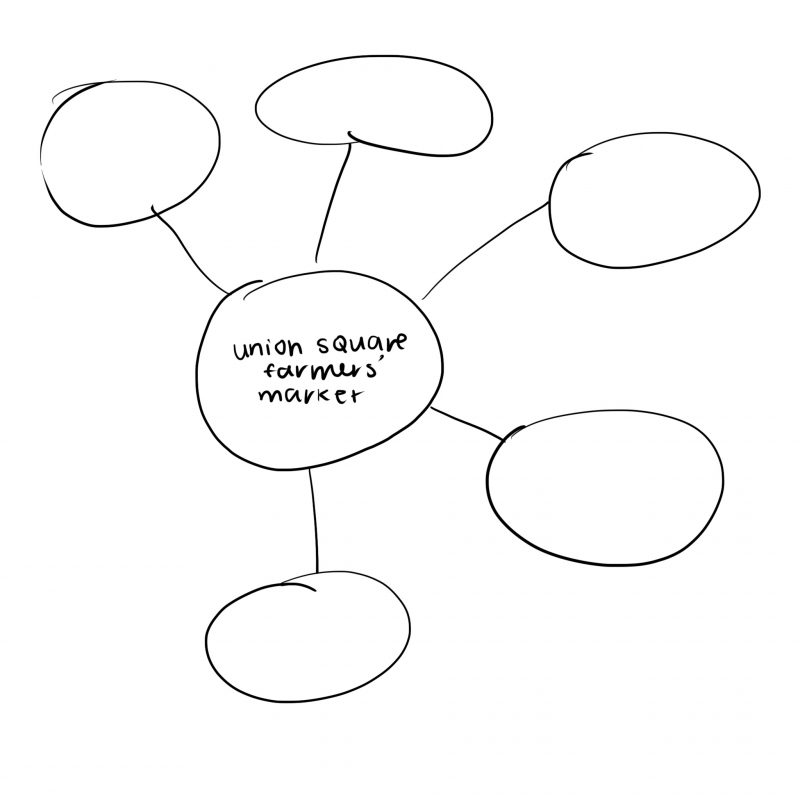
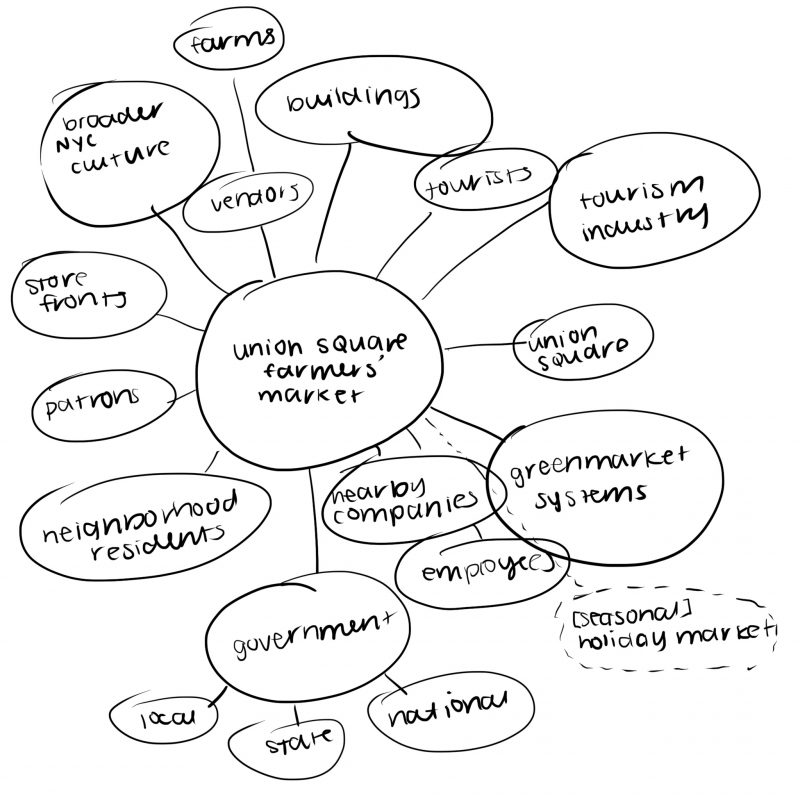
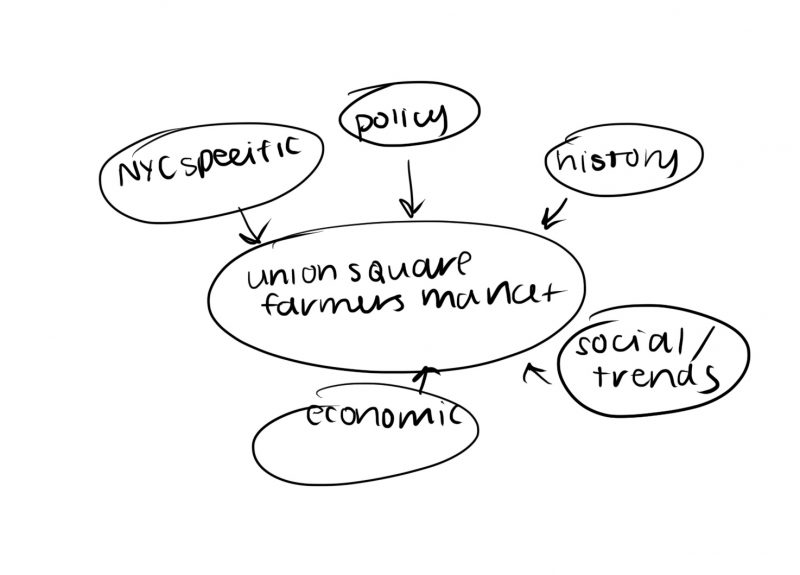
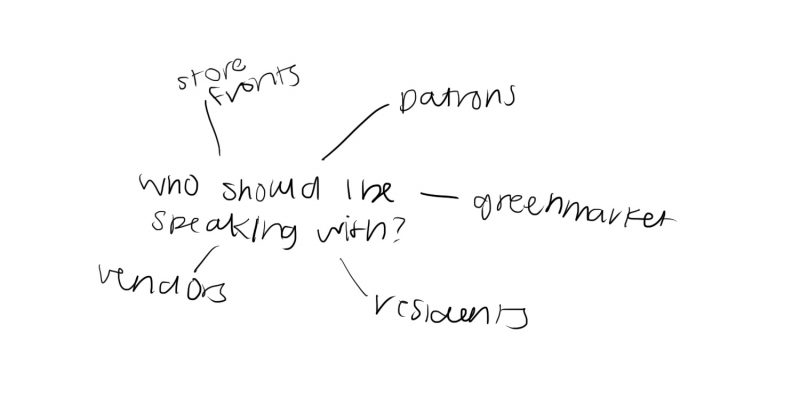
This informed different areas I could conduct secondary research on. What I learned from my secondary research then impacted the relationships, which would then fuel more research. I didn’t use Meadows’ traditional stock and flow diagrams [1], but I did find myself constantly thinking about the different related systems. I found this process to be a fluid and effective way to learn and process a wide spread of knowledge about a subject, documenting my secondary research notes and drawing diagrams throughout to begin mapping a broader context.
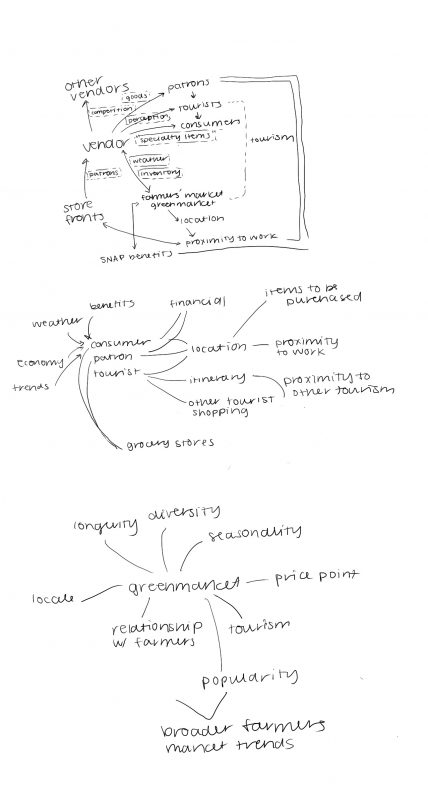
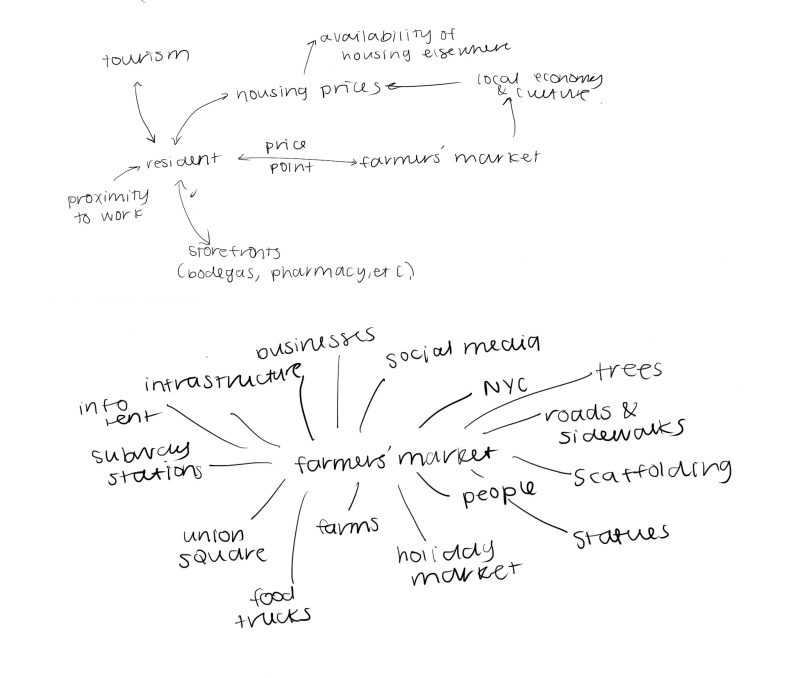
This context meant that, as I started to think about the Union Square farmers’ market, I also started to think about it within this broader context of systems, instead of just as an isolated object or place. Looking at it from a systems level, it’s easy to see how intersecting something as seemingly benign and simple as the Union Square farmers’ market could be.
This ultimately culminated in a larger working timeline that helped me synthesize and reflect on intersections between different lenses I was looking at. In the context of one another, you can start to make sense of how and why the Union Square farmers’ market emerged, and possibly why it was and has become so successful.

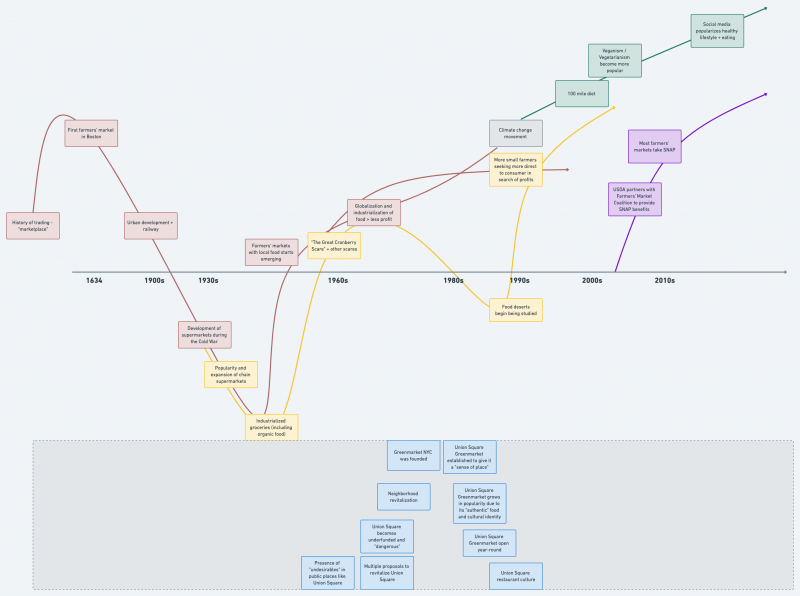
What initially started as a research project about this farmers’ markets really took a turn once I started “thinking in systems.”
I started to see relationships between how farmers’ markets grew out of the Cold War’s supermarket propaganda, the Industrial revolution and the subsequent mistrust in processed foods, the relationship to the climate change movement and healthy eating, and a need for higher profit margins for small farmers. I drew connections between Union Square’s Greenmarket development coming out of a low-budget neighborhood revitalization effort in order to drive crime out of the area and bring a more authentic, “urban” feel, making farmers’ markets targeted and accessible only for certain people, resulting in SNAP being accepted almost a decade later.
Farmers’ Markets as a “universal good”
Farmers’ markets are often seen as a universal good, for many reasons. They’re open to the public and “community” oriented, focused on connecting consumers with higher profits for local farms and businesses, and often contribute to more sustainable and healthy farming practices. We can easily assume they’ve been designed with community needs in mind. They seem to add a lot of value for a lot of people: for cities, for patrons, for local farmers and businesses.
And when you ask others what they think about farmers’ markets, people love them.
“I like talking to the farmers and getting to know them.”
“They make me happy because I love buying local.”
“I like to shop at farmers markets to support local farmers and small businesses.”
“Things like tomatoes are just fresher from a farmer.”
“I shop at farmers’ markets as a social thing.”
“I don’t go a lot, but when I do, it’s because I like supporting small local businesses.”
“It brings community together, and it’s so diverse.”
“It gives me a sense of belongingness and makes me feel at home.”
“I like walking around and seeing fruits and veggies I’ve never seen before.”
“I’m an advocate for the 100 mile diet so I try to shop local to support local farmers.”
“I feel like I get to experience New York City culture in one place.”
“Food helps people connect.”
“It brings so much to the community.”
But what happens when you start to look at the systemic complexities of something like the Union Square farmers’ market? Joanna Merwood Salisbury, in Design for the Crowd, writes, “Customers were happy because they felt they were participating in an authentic urban experience: an entirely satisfying sensory and sociable encounter…the Greenmarket gave the Square something vitally important to the strategies of place making: authenticity, a sense of providing a “real” urban experience…farmers’ markets such as the one in Union Square represented the return of a lost urban ideal, a vision of late twentieth- century community— one that would help overcome the deep social, racial, and economic divisions present in American cities [2].” Community is an extremely important aspect of farmers’ markets. However, is it possible that, by going to the farmers’ market, patrons feel that they’re contributing positively without knowledge of the complex histories, because they participate in a “community” that brings people together?
On and around the GrowNYC website [3], and in conversations surrounding farmers’ markets, the word “community” continues to come up a lot. But when you have people in the area historically getting displaced and replaced by farmers’ markets, it begs the question: what do we really mean when we say the “community,” and who really is included? Which “communities” are more important, and how do we, as a society, tend to prioritize? What does “community-driven design” mean, then?
“Community” in Design
The design world is another place that “community” is a frequently encountered term. We often hear of “community-driven design.” The Design Justice Network challenges existing design practices by encouraging more ethical and equitable design, and has created ten design principles that they encourage organizations to uphold throughout their design processes. Five out of their ten principles cite the word “community,” used in contexts such as, “We use design to sustain, heal, and empower our communities,” and ”We prioritize design’s impact on the community over the intentions of the designer [4].” While it’s incredibly important to prioritize people who are most impacted in any design context, which of course includes this broad term of “the community,” we should think critically about how we use the term. Like with farmers’ markets, we need to ensure that by using the term “community” broadly, that we aren’t just creating a blanket statement surrounding something positive and inclusive, when it may have exclusive elements by nature.
Because farmers’ markets uphold and prioritize an ideal that you’re contributing positively in supporting local and sustainable farmers, the markets can provide a seemingly authentic experience that make you feel like you’re absolved from harm based on your intent. However, through thinking in systems, we can see a history of exclusion in Union Square. Perhaps this unintentional “greenwashing” and emphasis on community can be just as, if not more harmful, than outright exclusive design.
If we say farmers’ markets are “community-driven,” but are actually designed to drive out crime, as was the case for the Union Square market, which “community,” then, are they actually designed for? Can we use the term “community” as a catch-all? By using words like “community” without breaking down nuance, are we enabling bias into future design, based on our assumptions of what “community” means?
Why is this important?
Similarly to how farmers’ markets are often considered a “good” thing, and tied inherently to “community,” our understanding of “community” can be similarly complex. We often accept what we mean by “the community” as a universal truth – something that we could always use more of, and is always good. As described by Miranda Joseph in Against the Romance of Community, “Community is almost always invoked as an unequivocal good, an indicator of a high quality of life, a life of human understanding, caring, selflessness, belonging [5].” This is especially true in design, as many designers see their roles as “advocates” or “facilitators” for community members or end users.
However, as designers, we hold a responsibility in which our actions have direct actions on the world around us. So if we don’t question what community means and what biases may be held in orienting ourselves around this acceptance of community as a universal good, who, then, are we designing for? What if our broad definition of community leads to unintentionally designing for dominant groups instead?
If we continue using community as a catch all, universal term, we risk doing exactly what the Design Justice Principles, and others, aim to prevent; very seldom is there just one community. So, then, which “community” do we design for? As designers, we hold a responsibility to respond ethically with well-informed and well-intentioned actions. But who are we to decide? And what is our role in the communities we intersect with?
References:
[1] Meadows, D. H., & Wright, D. (2015). Thinking in systems: a primer. White River Junction, VT: Chelsea Green Publishing.
[2] Joseph, M. (2006). Against the romance of community. Minneapolis: University of Minnesota Press.
[3] Greenmarket Farmers Markets. (n.d.). Retrieved from https://www.grownyc.org/greenmarket?gclid=Cj0KCQiA0NfvBRCVARIsAO4930miBKZNvCL0nkDBIXGVvlGWKyJPkg2D7lu03bwat_zg5Gre5uSZvFcaAp3pEALw_wcB.
[4] Read the Principles. (n.d.). Retrieved December 12, 2019, from https://designjustice.org/read-the-principles.
[5] Merwood-Salisbury, J. (2019). Design for the Crowd : Patriotism and Protest in Union Square. Chicago: University of Chicago Press.